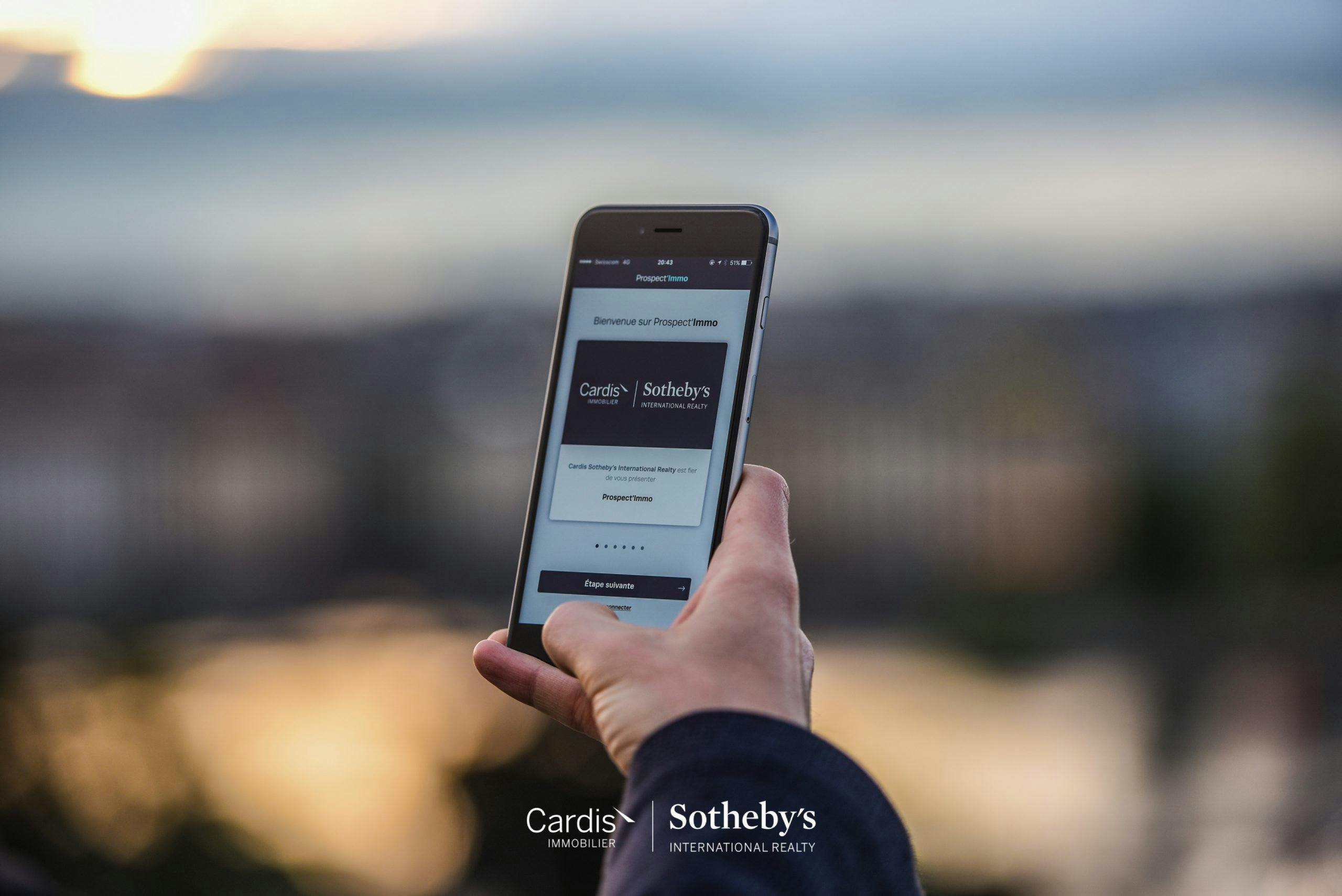

Cardis Sotheby’s International Realty
Application mobile ProspectImmo
Cardis Immobilier souhaite développer une application permettant à tout le monde de proposer des biens à vendre, à tout moment et depuis n’importe où.
prospectimmo.chBrief
Cardis Immobilier souhaite développer une application permettant à tout le monde de proposer des biens à vendre, à tout moment et depuis n’importe où. Cette application se devant d’être très simple à prendre en main et à utiliser, le challenge pour Antistatique est de créer des écrans adaptés et de réduire les étapes pour que l’effort soit moindre pour les utilisateurs.
Quelqu'un autour de vous cherche à vendre son bien immobilier ? Recevez jusqu'à CHF 2'000.- pour chaque information transmise concernant un bien immobilier à vendre dont vous avez connaissance.
Analyse et Étude
Money money money
L’un des principaux objectifs est de pousser les gens à utiliser l’application. Mettre en avant le fait de recevoir une commission est une solution séduisante qui poussera à la conversion. Après la prise en main des wireframes données par Cardis, nous nous sommes rendus compte que le fait de devoir créer un compte pouvait repousser certains utilisateurs à participer.

Solution proposée
Une app simple & attrayante
Afin de réduire au maximum les contraintes pour l’utilisateur, nous avons choisi de lui permettre d’entrer le bien avant toute autre étape, en lui proposant un minimum de champs obligatoires. Il est ensuite possible d’ajouter des photos prises directement avec son mobile.
Ce n’est qu’à la fin de l’opération, que celui-ci doit créer un compte. Le but étant de lui faire comprendre que c’est grâce à cela qu’il sera contacté si son bien est intéressant, plutôt que d’évoquer le concept de “compte” à proprement parler.
Pour rendre l’application attrayante, un grand travail d’illustration a été réalisé par Cardis, donnant ainsi une vie et une identité sympathique propre à l’application.


Le travail par sprints et par équipe
Comme le client souhaitait une mise en production très rapide, l’équipe a décidé de concentrer ses efforts et ses compétences sur une courte durée, par souci d’efficacité. Nos designers et nos développeurs, motivés par ce projet, se sont donc rassemblés pour de courts “sprints” durant lesquels ils se sont uniquement concentrés sur la création de l'app, sans aucune interférence du monde extérieur. Nous avons ainsi, une fois de plus, pu constaté que le travail en étroite collaboration, voire en isolation  , est très bénéfique.
, est très bénéfique.
 , est très bénéfique.
, est très bénéfique.Challenge et opportunités
- Vulgariser le vocabulaire du domaine de l’immobilier. Lors des tests utilisateurs, nous avons réalisé que certains termes n’étaient pas compréhensibles pour le public cible.
- Permettre l'ajout de contenu avant même de démarrer le processus de création de compte

Technologies utilisées
iOS
Afin d’être mise en production sur les stores d’Apple et de Google, l’app se devait d’être une app dite “native”. La deadline étant relativement courte, notre choix technique s’est donc rapidement porté sur le framework Ionic. Framework que nous maîtrisons d’ailleurs parfaitement, puisqu’il est basé sur des technologies que nous utilisons au quotidien.
Très rapidement, nous avons pu faire participer toute l’équipe et le client aux tests de l’app via TestFlight, le programme de Beta-testing proposé par Apple aux développeurs de leurs plateformes. Le déploiement de mises à jour est ainsi simplifié et utilise les canaux habituels, ce qui fluidifie grandement le test sur des appareils individuels (jamais besoin de les brancher, ni de les avoir au bureau par exemple...).
Android
Ionic a aussi le grand avantage d’aider à créer des apps totalement multi-plateformes. Après quelques optimisations spécifiques à son système, l’app était fonctionnelle sur Android et prête à être publiée sur le Google Play Store.
Symfony 3
Du point de vue de la gestion des données, toute l’app est basée sur un backend développé en Symfony. Le client peut donc gérer aisément toutes les entrées venant de l’app et intéragir avec l’utilisateur via un système de notification interne.
“ Nous devions mettre en œuvre une idée innovante dans l’immobilier sous forme d’une application pour mobile. Travaillant avec Antistatique depuis de nombreuses années, il nous paraissait évident de les contacter pour leur proposer le projet étant donné leur compétence dans les outils actuels web et digitaux. Ils ont tout de suite été très enthousiastes pour développer cette application. Il leur a fallu déterminer les bons outils afin que l’application soit multiplateforme et la plus conviviale possible. Au final, Prospect’Immo et sa plateforme pour gérer les demandes s’avèrent être simples à utiliser avec un graphisme ludique. Le mandat nous a donné entière satisfaction et il est toujours plaisant de travailler avec cette équipe dynamique et toujours de bonne humeur ! ”Fabrice Gay-Balmaz • Head of Marketing & IT

Terre des Hommes
project.teaser.a11y.servicesSite Web

Cardis Sotheby’s International Realty
project.teaser.a11y.servicesApplication Web
